Tradescantia is a houseplant favorite by flower growers, valued for its shade tolerance, originality of stems and leaves, and utmost simplicity of reproduction. The stems are thin, branched, capable of growing in length up to several meters. All types of tradescantia grow well, home care of which is extremely simple.
Material Content:
Tradescantia: types and varieties
This exotic comes from the tropical forests of South America, where due to the ability of shoots to quickly root, it has turned into a weed, forming entire thickets. All types of tradescantia are suitable for indoor floriculture.
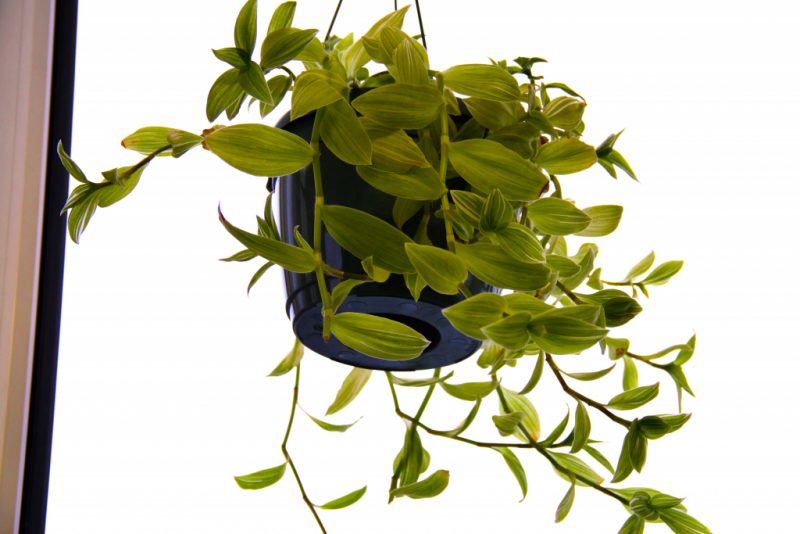
They differ mainly in the color and shape of the leaves, which can be light green, dark, terry, violet-green. The leaves of variegated varieties of tradescantia are decorated with numerous white stripes. With good lighting, the contrast between them and the green parts increases, which gives the flower even more decorative.
Types of tradescantion:
- More common white-flowered tradescantia with bright green leaves adorned with two silver longitudinal stripes. The underside of the sheet has a purple hue.
- Myrtle leaf tradescantia has bright silver flat against the background of a dark green leaf, the lower part of which is rich purple.
- Tradescantia zebrin, as you might guess, is also loved for the decorative stripes on the leaves. A distinctive feature is lilac stripes on a light green background.
- Tradescantia violet differs in monotonous violet color of leaves. The bush itself is slightly larger and fatter than other species.
- Tradescantia Virgin It does not stand out with striped patterns, but it has high cold resistance. In the southern regions of Russia, it can be grown even in open ground. The leaves are green, thin, elongated, the flowers are white, blue, pink, purple. From June to late autumn, it can bloom in a favorable climate.
Home Care
Indoor flower tradescantia compared to other plants is very unpretentious. Compliance with some nuances allows you to grow a beautiful branchy bush.
Temperature features, lighting, humidity
The optimum temperature for the development of tradescantia is 20-24 degrees. In winter, she does not need a cold wintering, but if she manages to keep her cool in the region of 16-18 degrees, she will thank him with a powerful growth wave in early March.
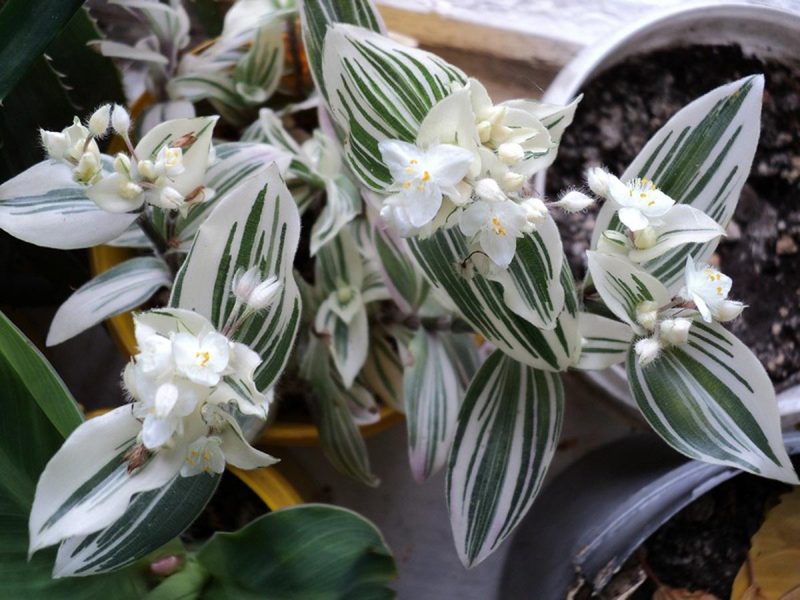
Tradescantia grow well in any light: from direct sunlight to stray light on the northern windows. But specimens that receive more light look more decorative, especially terry and striped varieties. It’s not worth, perhaps, to place pots in the back of rooms where light is catastrophically small for any plants.
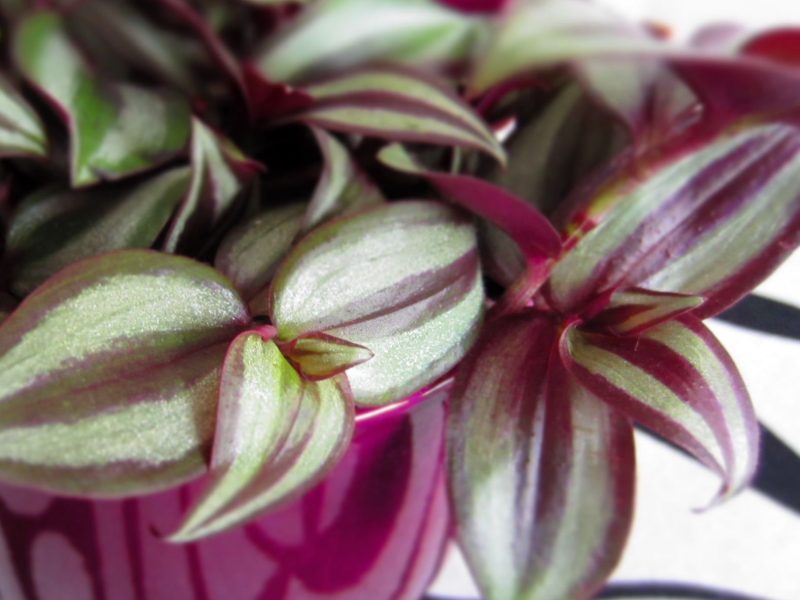
The positive humidification positively affects the growth of tradescantia. Many people prefer to spray green pets from a spray bottle, but this measure has a weak effect, since the moisture evaporates quickly. Other flower growers place containers with water around the plants, but in order for the vapor to somehow influence the growth of the flower, they need to make most of the window sill. The best solution is to place the tradescantia among other plants: green leaves give off a lot of water during the growing season. In addition, moss, the spores of which are present in any flower shop, can be sown in shallow plates, but you should not forget to water it abundantly.
Soil requirements

Tradescantia can adapt to any substrate, except for too heavy and waterproof soil. It grows best in a mixture composed of 2 parts of humus soil, 2 parts of leaf and 1 part of coarse sand. Suitable purchased universal primers for indoor plants are also suitable, which should be diluted with ordinary soil from a garden, garden or forest. If the substrate does not seem airy enough, you can pour a small amount of vermiculite, perlite, river sand or sawdust into it.
Watering and feeding
The plant loves abundant watering. Florists often get the impression that she is insatiable to water. To ensure safety, it should be planted in pots with a drainage hole and a layer of pebbles, stones or broken clay dishes at the bottom. It is convenient to use the cache-pot by hanging it on the window. Watering can be slightly reduced in winter, but the top layer of the earth in any case should not dry out.
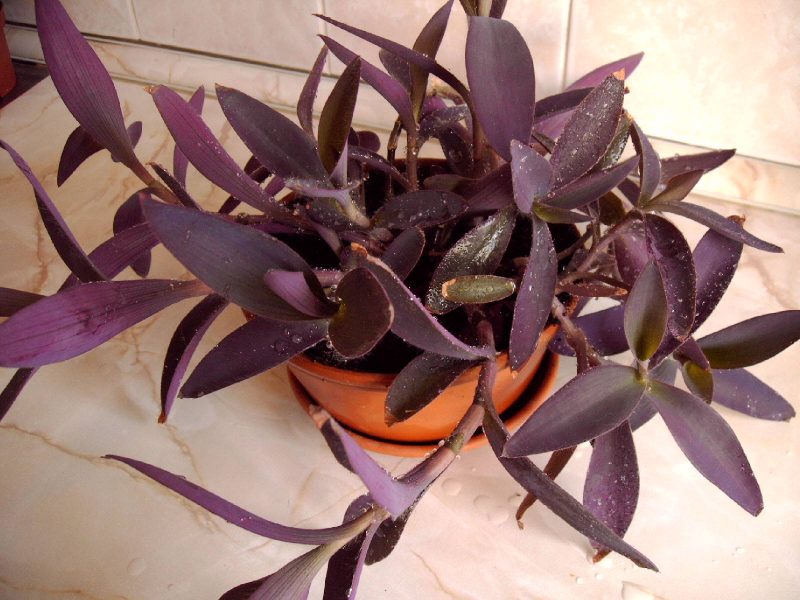
They respond positively to top dressing during the period of active growth. Fertilizing significantly accelerates the growth of green mass, increases the chances of flowering. You can water with solutions of universal fertilizers for indoor plants or tinctures of bird droppings. The response is also observed when applying mineral fertilizers, which are bred according to the instructions on the package. The ratio of nitrogen, phosphorus and potassium in the preparation of the solution should be approximately the same. In spring, you can fill up a little more nitrogen.
Important! Do not overfill the plant, as it has an increased tendency to rot!
Bloom

With good care, the plant almost always blooms in the open ground and in half the cases at home. Flowers can be white, purple, blue, pink. In order for the plant to give buds, it needs enough light and fertilizing once every 1-2 months.
Transplant and pruning
Transplantation of a tradescant is advisable only if the roots are tightly braided by an earthen lump, which is why it quickly dries up. The new pot should be several centimeters in diameter larger than the previous one.
Old overgrown tradescantia often discard leaves over most of the shoot length.As a result, only the ends of the branches remain leafy. In such cases, they are cut by 70-90%, and the resulting cuttings are cut into fragments 5-10 cm long, and put on rooting. The trimmed bush gives young shoots from the remaining hemp. If the result does not suit the grower, then new specimens can be grown from rooted cuttings.
Flower propagation
The easiest way to propagate is to put cuttings on the rooting in the water. If desired, rooting can be done in sand, vermiculite, perlite, and even in light soil. To increase the chances of success, the container with the handle can be covered with a bag or a transparent plastic cup, but even without this, the proportion of rooted cuttings usually reaches 95-100%. It is better to plant 2-3 plants together in a pot.
Much less often propagated by seeds. Fans of experiments can sow seeds in shallow containers with sandy soil, sprinkle them lightly, spray from a spray bottle and cover with a plastic bag. Shoots can be seen in 3-4 weeks. The following is the standard procedure for accustoming seedlings to dry room air: small holes are made in polyethylene every day or existing ones are expanded. After 1-2 weeks, the film can be completely removed.
Pests and diseases - how to treat?
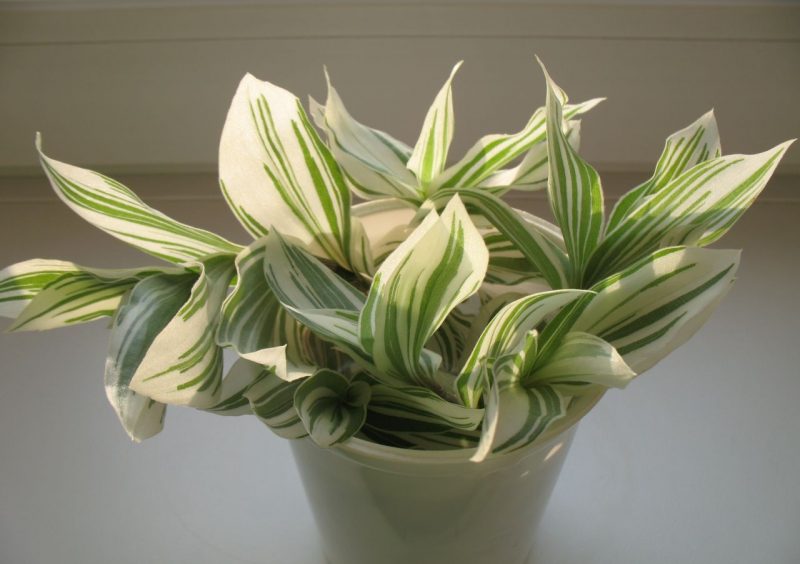
Pests usually do not have much interest in tradescantia. Sometimes a red spider mite, aphid, and occasionally scale insects settle on it.
| Name of disease or pest, description | How to fight |
|---|---|
| Aphid | Aphids are easy to remove with any insecticide. |
| Mite. This scary pest looks like a harmless small dot on the surface of a leaf. With increasing air humidity, it begins to move through the plant. | If the tick has not chosen the plant too tightly, then Fitoverm will help. Only it needs to be bred in a 1.5-2 times higher concentration than recommended on the package. 7-9 days after the first treatment, the second is carried out. If the tick no longer appears, then with some probability it was possible to defeat it. But it happens that he returns. |
| Root and root rot. | The best prevention is planting a plant in a light, moisture-permeable soil. |
Important! Tick eggs are viable for five years!
What problems can you face?

When growing a plant, you may encounter some problems:
- If the tips of the leaves turn brown and dry out, the most likely cause is low humidity.
- Sluggish for no apparent reason the stems and brownish-yellow spots on the leaves indicate either insufficient watering or hypothermia of the roots from too cold water. To prevent this from happening, the water collected from the tap is defended at room temperature.
- With a lack of light, the stems stretch excessively, and the internodes become long. It is important to remember that in the depths of the rooms the lighting is so insignificant that it is unacceptable for plants. You need to place flowers on the windowsills.
- The softening and rotting of the trunk at the root of the neck indicates the gulf. Such a plant is difficult to save, because by the time symptoms appear, the root system is already in a deplorable state. But you can take the stalk, root it and grow a new instance. If you still want to try to leave the affected plant, then you need to change the soil and cut the rotten roots.
In general, tradescantia is easy to grow, which does not cause difficulties. Perhaps this is the secret of its popularity.












